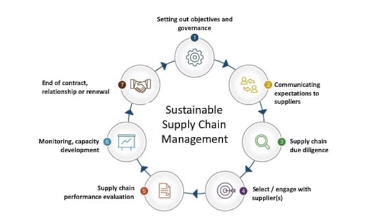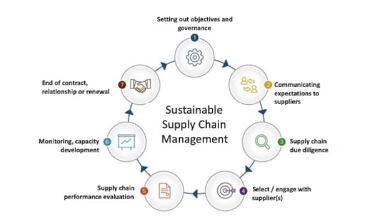Sustainability in Supply Chain Management

Building a sustainable supply chain management system continues to be a priority for many global businesses. Most companies recognize that managing and improving environmental, social and economic performance throughout their supply chains can help conserve resources, optimize processes and uncover new product innovations to reduce costs. Enhanced productivity promotes corporate values and responds to the growing chorus of stakeholders who are demanding cleaner and more responsible supply chains. While companies continue to extend and to expand their sustainability programs to include their supply chains, they sometimes struggle with actual implementation. There are numerous practical steps to establishing and maintaining a sustainable supply chain management system for your organization. It is becoming increasingly clear that supply chains play a critical role in our efforts to create more responsible and sustainable businesses, but how do we do this in practice and create an effective, responsible supply chain management system to help us?

Figure 1.1 Sustainable Supply Chain Map
In the illustration, 1.1 helps to illustrate some of the steps you might consider on your journey to the goal of creating an effective, responsible supply chain management system, and I should point out right away that many of these activities are laid out in a sequential or stepped approach. This is where you might adopt or develop your own code of conduct, aligning it with international standards and regulations, and considering cascading these requirements not only to your suppliers but also to your supplier suppliers, as well as engaging your suppliers in a meaningful discussion about supply chain sustainability and its importance to your business and theirs. Usually, it involves developing a detailed supply chain risk map which maps products and traces the flow of materials and information and will also involve carrying out some due diligence and information gathering on human rights, labor, environmental and corruption risks at every step of the production chain. Once this is completed, we can proceed to the next stage, in which we engage with our key suppliers once more to ensure shared understanding of our organizational objectives, establish proper oversight controls, and, if possible, begin to transfer ownership of these objectives to the suppliers themselves.
The activities at this stage would include the development of scorecards which would seek to integrate typical procurement considerations of price and quality with sustainability related issues. Sustainability obligations are written into the legal contracts at this stage and establish any incentives or penalties for suppliers for any breaches of the code of conduct or for their poor performance. Once we’ve set up the terms of engagement with the suppliers, it’s often not enough to rely on these verbal or contractual commitments. We need to actively engage in due diligence activities to assess the environmental, social and governance performance of our suppliers in order to ensure compliance with our company’s expectations. This may involve self assessment, on-site audits, supply chain management certifications and a review of operational level grievance mechanisms.
In addition to conducting supplier assessments, it is critical that we monitor the ongoing performance and effectiveness of the sustainable supply chain management system as a whole. What has changed as a result of the program is that it has achieved its objectives, and we also want to ensure that we are monitoring their overall performance so that we can build ongoing capacity within the supply chain. It allowing us to step back and assess the supplier relationship based on quality data and effective engagement with our suppliers on issues that are important to this company’s sustainability performance and, concludes our at-a-glance summary of what activities and elements organizations might consider when moving to developing a more responsible and sustainable supply chain. It is not intended to be prescriptive, as each organization will have its own context and priorities.
References :
Cetinkaya, B., Cuthbertson, R., Ewer, G., Klaas-Wissing, T., Piotrowicz, W., & Tyssen, C. (2011). Sustainable Supply Chain Management: Practical Ideas for Moving Towards Best Practice (2011th ed.). Springer.
Fritz, M. M. C. (2019). Sustainable Supply Chain Management. Encyclopedia of the UN Sustainable Development Goals, 1–14. https://doi.org/10.1007/978-3-319-71062-4_21-1
The Importance of Sustainability in Supply Chain Management. (2020, October 30). Prologis. https://www.prologis.com/about/resources/sustainability-in-supply-chain-management#:%7E:text=Sustainable%20supply%20chain%20management%20starts,transportation%20of%20goods%20and%20beyond.
Sustainable Business by Trine. (2016, December 19). Sustainability and Supply chain [Video]. YouTube. https://www.youtube.com/watch?v=x0d8sfl1tq4&t=40s
Sustainable supply chain management: A review of literature and implications for future research | Emerald Insight. (2018, June 8). Emerald. https://www.emerald.com/insight/content/doi/10.1108/MEQ-01-2018-0003/full/html

